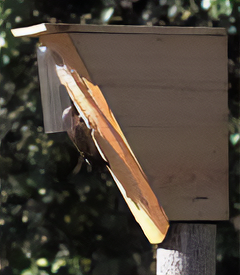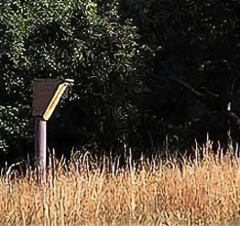Research > Woodpeckers (Family Picidae)
Woodpeckers peck at wood. They do it to uncover insects that hide under the bark. They do it to carve out small hollows in tree trunks to use as homes. And sometimes they do it as a way of talking to each other.
1
In the early spring they can be heard hard at work making nest sites in the sides of tall trees. Other birds are sometimes interested in their energetic occupation.
Image: Starling watches common flicker at new nest cavity.
2
The European starling which was brought to North America in the nineteenth century also likes to nest in hollow cavities in trees. But the starling cannot excavate the wood, so it watches the woodpeckers and waits for them to finish. Once the woodpecker is done, the starling comes and evicts it from its home. Now the woodpecker must start all over again at a new tree. And then more starlings come and chase the woodpecker once more.
Image: Flicker being ousted from nest by starling.
3
In order to help the woodpecker overcome the problem. caused by introducing this bird to the western hemisphere, Native America has designed an artificial nest box with a clear plastic shield: "The Woodpecker Protector". Woodpeckers climb up the front of the box, up under the shield, and into the entrance hole.
Image: Flicker using Native America nest box with shield.
4
Once inside the woodpecker is now protected from intrusions by the starlings. It is safe to nest and incubate. The young woodpeckers wait inside for food and grow large and full of feathers. Ordinarily it is dark inside the cavity and the young practice stretching their wings and calling.
Image: Flicker nestlings in Native America nest box.
5
The parents bring food into the nest box for the young. And when the parents leave, they must also remove the droppings of the young to keep the inside of the nest box clean. They carry the fecal sacs of the young out of the nest box and fly it to a spot far from the nest.
Image: Adult flicker bringing food to nestlings in protected nestbox.
6
Starlings cannot climb up vertical surfaces like woodpeckers can and so cannot get into the shielded nest box. They look to fly directly into the entrance hole and are thus prevented from using these nest boxes.
Image: Starling being kept from entering Native America nestbox by plastic shield.
The Woodpeckers Nest Box
1
Native America began the research for the Woodpecker Nest Box in 1994. The first prototype was a clumsy section of a hollowed out log propped up on a painted cyclone fence post. A crude rounded piece of plastic was attached to the front entrance hole.
Image: First nest box prototype made from hollow log.
2
While the early prototype worked, starlings were still able to get in from time to time. It was only after years of experimentation that the shield was fine tuned to just the right size and dimension. It was also important to shape the nest box to conform just right to make the whole thing work properly.
Image: Flicker using woodpecker nest box with plastic shield.
3
Native America continues to field test the Woodpecker nest box throughout North America. It is important to broaden the range of woodpecker species that will use the nest box. It is also important to study the territorial ranges, migratory dispersal, and habitat preferences with this concept. In 1999, the Woodpecker Nest Box with the inclusive protective shield became available for private and public use.
Image: Native America woodpecker box in the field.









